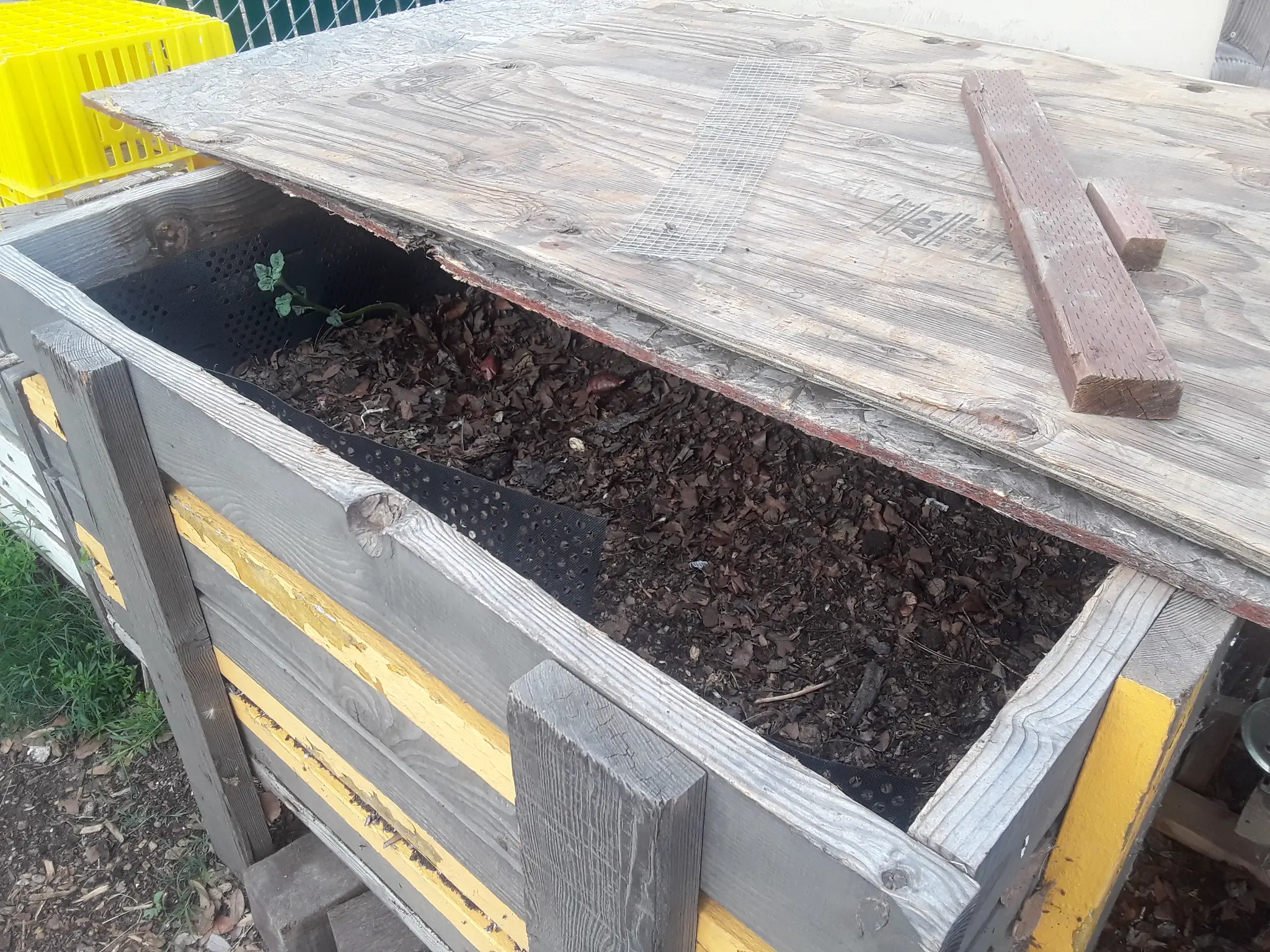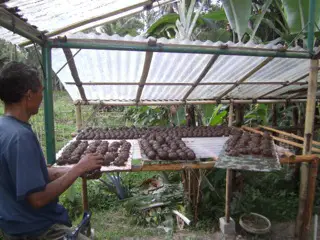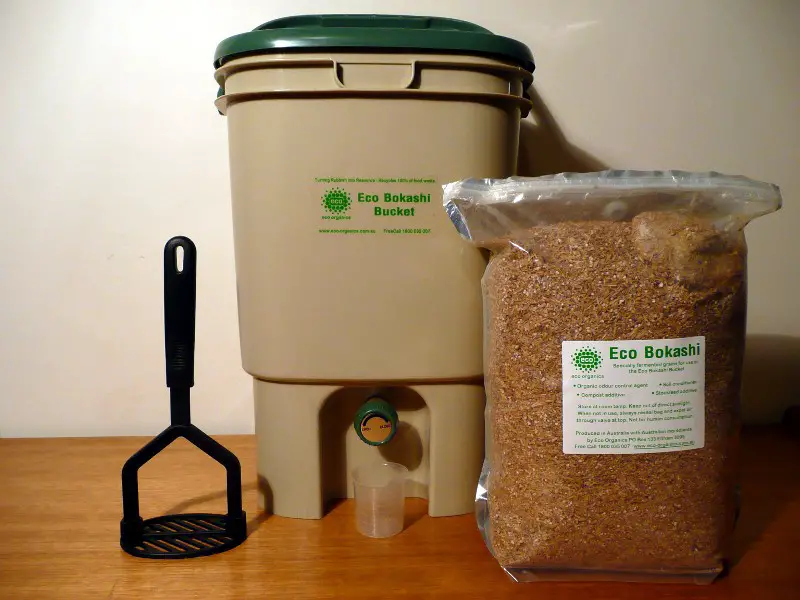Bokashi composting is a method of processing food scraps in an anaerobic environment. A bran or grain inoculated with effective organisms (EM) is tossed on the food scraps. This inoculated bran is referred to as Bokashi EM, and the microbes in this substance break down the food.
Bokashi composting is a great option for people who want to compost but live in a small space. Although Bokashi produces pickled food scraps rather than finished compost, there are a number of benefits over traditional composting. For example, Bokashi composting processes food waste quickly, and you can compost meat scraps in a Bokashi Bin.
Bokashi compost, the leachate from a Bokashi bin, and Bokashi EM can be used for a number of purposes. Some of these uses are listed below.
Bury The Bokashi Pre-Compost In Existing Gardens
Bokashi pre-compost is essentially pickled food scraps. Unlike traditional composting, the final product of Bokashi compost is not a finished compost product that looks like potting soil. As a result, it is necessary to perform a second step that will finish the composting process.
One of the most common ways to finish Bokashi pre-compost is to bury it in an existing garden or around the base of a tree. Because Bokashi pre-compost is very acidic, it is important to bury your pickled food scraps in a spot that is at least 9 to 12 inches away from any existing plant roots to avoid killing your plants. After a couple of weeks, the Bokashi pre-compost will neutralize and begin to provide nutrients to the soil.
Rather than burying Bokashi pre-compost in a garden, you can actually create a “soil factory” by burying your Bokashi pre-compost in a bin full of potting soil. This will result in a nutrient-rich potting mix that will promote healthy plant growth. Soil factories are a good option for gardeners who do not have access to a large garden space.
It is also important to make sure that you cover Bokashi pre-compost with at least 12 inches of soil. This is because dogs, rodents, and even chickens are attracted to the smell of the pickled food scraps.
Use Bokashi Tea As A Fertilizer For Houseplants
Bokashi tea, which is a term that describes the liquid that needs to be drained from a Bokashi bin on a regular basis, can be used to fertilize your houseplants and other garden plants. Bokashi tea contains microbes and nutrients that improve plant growth. However, this juice/leachate is very acidic. As a result, it is important to dilute Bokashi tea before applying it as fertilizer. The EM Research Organization (EMRO) recommends diluting Bokashi tea 500 to 1,000 times.
A study conducted by researchers in Estonia found that Bokashi tea improved the growth of tomato transplants by increasing the stem diameter and by allowing for the plant to take up more nutrients (Olle, 2020).
EM Soap
People are also finding out that EM does not only nourish your plants, it will nourish your body. Several companies are now incorporating effective microorganisms (EM), which could be considered the “active ingredient” in Bokashi compost, into bath and body products. For example, a Japanese businessman named Kazuhiro Iwai opened a “Ferment Bathing Spa Iwai” with his family in Inashiki City, Ibaraki. They mix sawdust and rice bran fermented with EM ceramics powder for used as a dry hot sand bath. In addition, they provide their guests with EM body soap and shampoo.
There are several types of EM soap sold on Amazon and other online marketplaces. After doing a little research, this soap costs between $5 and $10 per 4 oz bar. This is around the same cost as other premium soaps you may see sold in gift shops or on Etsy.
To make your own EM soap, you will need to use some of the more “traditional” soapmaking chemicals such as lye. Lye can be extremely dangerous if ingested, so exercise extreme caution if you have pets or small children in your home. The leaflet below, which was published by the EM Research Organization (EMRO) outlines the steps for making your own EM soap.
Use Bokashi Tea As A Weedkiller
Bokashi tea can also be used as a weedkiller. However, you may need to apply Bokashi tea a couple of times in order to kill particularly pesky weeds such as dandelions or buttercups. Bokashi tea is very acidic, so is an effective way to kill weeds. There is no need to dilute Bokashi tea when using it as a weedkiller.
Another benefit of using bokashi tea as a weedkiller is that you will not be exposed to the dangerous chemicals in commonly used herbicides such as RoundUp.
It is important to note that you should be very careful not to get any of this liquid on your other plants. Bokashi tea will kill desirable plants as well, especially more sensitive ones.
Add Bokashi Pre-Compost To A Worm Bin

Composting with worms, which is referred to as vermicomposting, is becoming an increasingly popular way to compost in smaller spaces. Bokashi composting results in a product with a pH between 3 and 4. Worms do not like substances that are this acidic. However, you can still add Bokashi pre-compost directly to a vermicompost bin. Many people have found that the worms love the Bokashi pre-compost as it begins to break down.
However, there are a few things you should do to ensure that your vermicomposting bin continues to thrive after adding Bokashi pre-compost. First, only add small amounts of Bokashi pre-compost to start. Then add more as the worms get used to the pickled food scraps. In addition, it is important to continue to add more “browns” such as cardboard and paper as you add Bokashi pre-compost. Finally, add lime to neutralize the acidity of the Bokashi pre-compost.
You can also add Bokashi pre-compost to a large compost pile. The beneficial microbes (EM) in the Bokashi pre-compost will give your compost pile a boost by speeding up the decomposition process.
Use Bokashi Tea To Unclog Pipes
As previously mentioned, Bokashi tea is very acidic (pH between 3 and 4). This makes it an effective substance for unclogging pipes. The microbes in the Bokashi tea work to break down the sludge and debris that accumulate in pipes. It also discourages plant roots from growing in the pipes. To unclog pipes with Bokashi tea, simply put your Bokashi bucket in the sink and open the spigot. There is no need to dilute Bokashi tea in order to use it to unclog pipes.
Allow water to run for a few seconds after pouring the Bokashi pre-compost down the drain. This will prevent unpleasant odors from filling the room. If your pipes are badly clogged, you may want to consider not rinsing the Bokashi pre-compost for a few hours to allow the bacteria a chance to work.
Bokashi Bran Mixture Can Be Used To Compost Pet Waste
EM stands for “effective organisms.” The EM technology was developed a over a number of years by Dr. Teruo Higa while he was a professor of horticulture at the University of the Ryukyus in Okinawa, Japan. EM is a mixture of microbes that is used to inoculate grain or rice to make Bokashi bran. This Bokashi bran helps to break down organic matter into a usable form called Bokashi compost.
Although Bokashi composting is typically used to process food scraps, you can actually compost pet waste. Pet waste is a nuisance for many people. You cannot leave it on the ground, and pet waste will stink up any room or garage when thrown in the trash. Bokashi composting allows you to dispose of your pet’s waste in an environmentally friendly way while also minimizing unpleasant odors.
Although using Bokashi composting is a safe way to deal with pet waste, you should not use composted pet waste on food crops. Pet waste can contain harmful parasites or pathogens.
EM-1 Microbial Inoculant Can Be Added To Hydroponic Systems
You can also add an EM-1 Microbial Inoculant to hydroponic systems. The beneficial microbes provide nutrients to plants and improve water quality. Click here to purchase EM-1 Microbial Inoculant on Amazon.
Bokashi Bran Can Be Used For Odor Control
Animal pens and litter boxes can get quite gross as waste and ammonia builds up. Mixing a few handfuls of Bokashi bran into animal bedding or litter can minimize animal odors. The anaerobic microbes in Bokashi will feed on wet animal waste in livestock pens or litter boxes.
Bokashi bran, which is rice or grain inoculated with effective microorganisms (EM), is not harmful to pets or wildlife. Some people even use Bokashi bran as animal feed.
EM Can Be Used To Clean Ponds
As previously mentioned, EM stands for “effective organisms” and is a mixture of microbes that breaks down organic matter into a usable form called Bokashi compost. However, EM can be used for several other purposes such as cleaning ponds.
Treating your pond or aquarium with EM-1 will keep the nutrient level levels in the water low. This, in turn, improves water clarity. TeraGanix, who is a manufacturer of EM-1, recommends adding EM-1 to your pond monthly. It will take a few weeks for the EM-1 to work, but the slime at the bottom of the pond will eventually rise to the surface. This slime/muck will disappear naturally.
Some people will also create “Bokashi Balls” for the purpose of cleaning ponds or other bodies of water. This involves rolling bokashi bran into clay soil and adding the balls to water.

Source: http://www.jiwadamai.net/
The following PDF describes how to make your own Bokashi mudballs.

